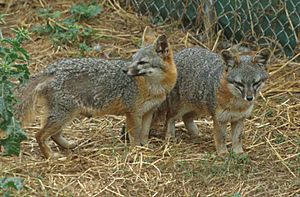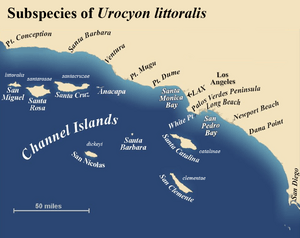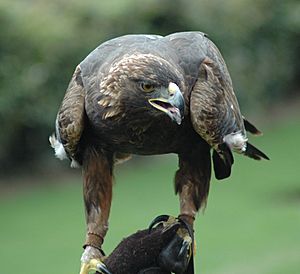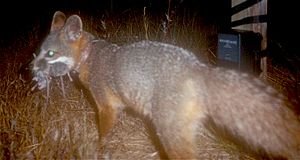Island fox facts for kids
Quick facts for kids Island Fox |
|
|---|---|
 |
|
| Conservation status | |
| Scientific classification | |
| Kingdom: | |
| Phylum: | |
| Class: | |
| Order: | |
| Family: | |
| Genus: |
Urocyon
|
| Species: |
U. littoralis
|
| Binomial name | |
| Urocyon littoralis (Baird, 1857)
|
|
 |
|
| Range map | |
The island fox (Urocyon littoralis) is a small fox that lives only on six of the eight Channel Islands of California. There are six different types, called subspecies, and each one lives on its own island. This shows how they have changed over time to fit their island homes.
Island foxes are usually calm and don't seem afraid of people. They can even be easily tamed. Long ago, island foxes were important to the Native Americans who lived on the Channel Islands. They might have been kept as pets, used for their fur, or even helped with pest control.
Contents
Island Fox Family Tree and History
The island fox is related to the mainland gray fox. Both belong to the same group, or genus, called Urocyon. The island fox is much smaller than the gray fox. This small size is an example of something called insular dwarfism. This means animals on islands often become smaller over time because there isn't as much food or space.
There are six different types of island foxes, called subspecies. Each one lives on a specific Channel Island and developed there on its own. These subspecies are:
- Urocyon littoralis littoralis from San Miguel Island
- Urocyon littoralis santarosae from Santa Rosa Island
- Urocyon littoralis santacruzae from Santa Cruz Island
- Urocyon littoralis dickeyi from San Nicolas Island
- Urocyon littoralis catalinae from Santa Catalina Island
- Urocyon littoralis clementae from San Clemente Island
Even though foxes from different islands can have babies together, they have small differences in their genes and how they look. For example, the subspecies have different numbers of bones in their tails, called vertebrae.
The island fox's small size helps it survive with the limited food and space on the islands. Scientists believe these foxes arrived on the northern islands between 10,400 and 16,000 years ago. They might have "rafted" there on floating debris. During the last ice age, sea levels were lower. This made four of the northern islands connect into one big island, and the distance to the mainland was shorter. It's thought that Native Americans brought the foxes to the southern islands. They might have kept them as pets or hunting companions.
People have called the island fox by many names. Some of these include coast fox, short-tailed fox, island gray fox, and Channel Islands fox.
What the Island Fox Looks Like
The island fox is much smaller than the gray fox. It is the smallest fox in North America. It's even a bit smaller than the swift fox and kit fox.
Island foxes are about 48 to 50 centimeters (19 to 20 inches) long from head to body. They stand about 12 to 15 centimeters (5 to 6 inches) tall at the shoulder. Their tail is quite short, only about 11 to 29 centimeters (4 to 11 inches) long. This is much shorter than the gray fox's tail, which can be 27 to 44 centimeters (11 to 17 inches) long. The island fox has fewer tail bones than the gray fox. An island fox usually weighs between 1 and 2.8 kilograms (2.2 and 6.2 pounds). Male foxes are always a bit bigger than females. The largest island foxes live on Santa Catalina Island, and the smallest ones are found on Santa Cruz Island.
The island fox has gray fur on its head. Its sides are a reddish-brown color. Its belly, throat, and the lower part of its face are white. It also has a black stripe along the top of its tail. Overall, their fur is a bit darker and not as bright as the gray fox's fur.
Reproduction and Life Cycle
Island foxes usually form monogamous pairs, meaning they stay with one partner for breeding. You can often see these pairs together starting in January and through the breeding season, which is from late February to early March. The mother fox carries her babies for about 50 to 63 days.
Female island foxes give birth in a den. A typical litter has one to five pups, but usually two or three. The pups are born in the spring and come out of the den in early summer. The mother feeds them milk for about 7 to 9 weeks.
Island foxes can start having babies when they are about 10 months old. Females usually breed in their first year. In the wild, island foxes live for about 4 to 6 years. In places like zoos, they can live up to 8 years.
Life and Behavior
Island foxes like to live in places with lots of woody shrubs that produce fruit all year. They live in all the different types of environments on the islands. These include forests, grasslands, and chaparral (a type of shrubland). No single island has more than 1,000 foxes.
These foxes usually move around by themselves, not in groups. They are mostly nocturnal, meaning they are active at night. However, they are most active around dawn and dusk. Their activity also changes with the seasons. They are more active during the day in summer than in winter.
Island foxes are not scared of humans, though they might act a bit aggressive at first. They are generally calm and can be easily tamed.
Island foxes communicate using sounds, smells, and body language. A dominant fox might use barks, growls, staring, and flattening its ears to show another fox who's in charge. They also use their faces and body positions to show if they are dominant or submissive. Their main sounds are barking and growling. Island foxes also mark their territory with urine and poop.
What Island Foxes Eat
The island fox has a varied diet. It eats fruits, insects, birds, eggs, crabs, lizards, and small mammals. This includes deer mice.
Protecting the Island Fox


Because island foxes live only on islands, they don't have strong protection against diseases and parasites that come from the mainland. They are especially at risk from diseases that domestic dogs might carry. Also, in the 1990s, golden eagles and human activities caused fox numbers to drop greatly on several Channel Islands. Golden eagles are much bigger than island foxes and can easily hunt them.
In 2004, four types of island foxes were officially listed as endangered species by the government. This means they were in danger of disappearing forever. Since then, people have been working hard to help fox populations grow again and to restore the natural environments of the Channel Islands. One way they do this is by putting radio collars on young foxes to track them. So far, these efforts have been very successful!
Images for kids
See also
 In Spanish: Zorro isleño para niños
In Spanish: Zorro isleño para niños







